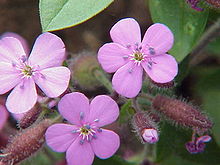Saponaria
| Saponaria | |
|---|---|

| |
| Saponaria ocymoides | |
| Scientific classification | |
| Kingdom: | |
| (unranked): | |
| (unranked): | |
| (unranked): | |
| Order: | |
| Family: | |
| Genus: | Saponaria |
| Species | |
|
30-40, see text | |
Saponaria is a genus of flowering plants in the pink family, Caryophyllaceae. They are native to Europe and Asia, and are commonly known as soapworts.[1]
They are herbaceous perennials and annuals, some with woody bases. The flowers are abundant, five-petalled and usually in shades of pink[2] or white.[1]
The most familiar species might be common soapwort (S. officinalis), which is native to Eurasia but is known in much of the world as an introduced species, often a weed, and sometimes a cultivated ornamental plant.[1] The genus name Saponaria derives from the Latin sapo ("soap") and -aria ("pertaining to"),[1] and at least one species, S. officinalis, has been used to make soap.[3] It contains saponins, and a liquid soap could be produced by soaking the leaves in water.[1] This soap is still used to clean delicate antique tapestries.[4]
The genus is closely related to Lychnis and Silene, being distinguished from these by having only two (not three or five) styles in the flower.[2] It is also related to Gypsophila, but its calyx is cylindrical rather than bell-shaped.[5]
Saponaria species are eaten by the larvae of some Lepidoptera, including the Lychnis and Coleophora saponariella, which is exclusive to the genus.
Diversity
There are 30[5][6] to 40[1][7][8] species in the genus.
Species include:[9]
- Saponaria bargyliana[10]
- Saponaria bellidifolia
- Saponaria caespitosa
- Saponaria calabrica – Adriatic soapwort
- Saponaria karapinarensis[11]
- Saponaria kotschyi[12]
- Saponaria lutea
- Saponaria ocymoides – rock soapwort, tumbling-Ted
- Saponaria officinalis – bouncingbet, sweet Betty
- Saponaria pamphylica[13]
- Saponaria pumila[14]
- Saponaria pumilio – pygmy pink
- Saponaria sicula
- Saponaria suffruticosa[15]
References
- ^ a b c d e f Saponaria. Flora of North America.
- ^ a b RHS A–Z Encyclopedia of Garden Plants. United Kingdom: Dorling Kindersley. 2008. ISBN 1405332964.
- ^ Coombes, A. J. (2012). The A to Z of Plant Names. USA: Timber Press. p. 265. ISBN 9781604691962.
- ^ Elliot, Doug. Wild Roots: Forager's Guide to the Edible and Medicinal Roots, Tubers, Corms and Rhizomes of North America. ISBN 978-0892815388.
- ^ a b Saponaria. Flora of Pakistan.
- ^ Saponaria. Flora of China.
- ^ Jürgens, A., et al. (2003). Flower scent composition in Dianthus and Saponaria species (Caryophyllaceae) and its relevance for pollination biology and taxonomy. Biochemical Systematics and Ecology 31(4), 345-57.
- ^ Saponaria. The Jepson eFlora 2013.
- ^ Saponaria. GRIN.
- ^ Mutlu, B. (2006). Saponaria bargyliana Gombault (Caryophyllaceae): a new record for Turkey and analysis of its morphological characters with related species. Turk. J. Bot 30, 63-70.
- ^ Vural, M., et al. (2006). Saponaria karapinarensis, Senecio salsuginea and Centaurea tuzgoluensis, three new species from central Anatolia, Turkey. Belgian Journal of Botany 139(2), 252-60.
- ^ Ataslar, E. (2004). Morphological and anatomical investigations on the Saponaria kotschyi Boiss.(Caryophyllaceae). Turk. J. Bot 28, 193-99.
- ^ Çinbilgel, İ., et al. (2007). Morphological and anatomical study on endemic Saponaria pamphylica Boiss. & Heldr.(Carypohyllaceae). J. Appl. Biol. Sci 1, 19-25.
- ^ Tribsch, A., et al. (2002). Saponaria pumila (Caryophyllaceae) and the ice age in the European Alps. American Journal of Botany 89(12), 2024-33.
- ^ Dönmez, A. A. (2009). Saponaria suffruticosa (Caryophyllaceae): An enigmatic species from south-west Asia on border of Turkey and Iraq. Hacettepe J Biol 37(3) 181-87.
External links
- Saponaria. USDA PLANTS.
- Saponaria. ITIS.
